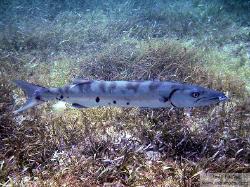

Picuda o Barracuda
Great Barracuda
Sphyraena barracuda
Great Barracuda
Sphyraena barracuda
| Photos and text by David Nuñez |
| La familia de las Barracudas, incluye a 18 especies que habitan en los oceános tropicales y subtropicales del planeta. Tienen un cuerpo alargado, con una quijada inferior prominente que exhibe grandes y filosos dientes. Su reputación como depredadores feroces de otros peces es bien merecida, pero los ataques comprobados a bañistas son muy escasos y normalmente ocurren bajo condiciones de poca visibilidad y en ocasiones en que humanos alimentaban o provocaban a éstos peces. Cuando ocurren, los ataques constan de una sola mordida rápida que no se repite. Es posible que su reputación se deba en parte a su tendencia a aproximarse a buzos por curiosidad. Como precaución, se recomienda entrar al agua sin joyería (relojes, aretes) que pueda destellar y llamarles la atención. Los jóvenes forman pequeños grupos, y aunque los adultos también pueden hacerlo, normalmente son solitarios. A estos individuos ocasionalmente se les puede ver controlando cardúmenes de otros peces en aguas someras, alimentándose de ellos a su antojo. A éste pez se le encuentra tanto en mar abierto, como en el arrecife, sobre pastos marinos o entre manglares. Aúnque se le ve comunmente en aguas someras, pueden nadar a profundidades de hasta 100 metros. Sus larvas se esconden entre vegetacion marina en aguas someras, y los jóvenes pasan su primer año entre manglares y pastos marinos, antes de proceder al arrecife en su segundo año. Los jóvenes pueden cambiar de color de acuerdo a su entorno. Pueden llegar a medir hasta 2 metros de longitud y pesar hasta 50 kg. Se calcula que viven alrededor de 14 años. La Picuda depende de la vista para cazar, por lo que es activa durante el dia y prefiere aguas cristalinas. Su cuerpo hidrodinámico les permite nadar a 55 km/h en breves piques que sorprenden a sus presas. A su vez este pez puede ser comido por tiburones, atúnes, ó meros Itajara. |
| The Barracuda family includes 18 species across all tropical and subtropical oceans worldwide. They have an elongated body with a protruding lower jaw that displays large sharp teeth. Their reputation as fierce predators of other fish is well deserved, but documented reports of attacks on swimmers are extremely rare. These cases seem to be related to conditions of low-visibility, and occasions in which humans were feeding or otherwise provoking the animals. They usually involve a single quick bite which is not repeated. Perhaps their tendency to approach divers and snorkelers out of curiosity adds to their fearsome reputation. To discourage unwelcome attention, swimmers may want to remove any shiny jewelry before going in the water. Juveniles are often found in small schools, and though adults may also form groups they are usually solitary. Individuals may also herd schools of prey fish, keeping them in shallow waters and feeding on them at will. The Great Barracuda are found in both open water or near coastal reefs, seagrass beds and mangroves. Though often seen in shallow waters, they are also found at depths of up to 100 meters. Larvae settle in shallow waters with abundant vegetation and juveniles spend their first year hiding out among mangroves or seagrasses, before moving on to the reef in their second year. Juveniles can change color to match their surrounding. They can grow to be 2 meters in length and weigh 50 kg. Their lifespan is estimated around 14 years. Great Barracuda rely on their eyesight to catch a large array of prey, so they are active during the day and prefer clear waters. Their streamlined body allows them to swim at up to 55 km/h for short surprising bursts. They in turn may be eaten by sharks, tuna or Goliath grouper. |
| Recomendamos estos libros sobre la Fauna de México. (Los nuestros son bilingues.) |
| To learn more about the Wildlife of Mexico, we recommend the following books. |













